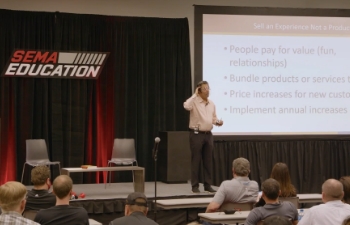SEMA News—April 2020
RETAIL BEST PRACTICES
Guarding Against Retail Theft
Engagement Is the Key Factor in Deterrence
 Whether by shoplifters, employees or after-hours burglars, theft can have devastating effects on a retail operation. Fortunately, there are a number of best practices you can adopt to protect your business from such thievery. Courtesy: Shutterstock.com |
As a retailer, are you doing everything you can to minimize loss from theft? Whether it results from shoplifters, employees or vendors, theft remains a leading cause of “inventory shrinkage” and operational loss among retailers. In fact, according to the National Retail Foundation (NRF), inventory shrinkage cost the U.S. retail industry $46.8 billion in the last year. The NRF further set the average shrink rate for a retail business at 1.33% of sales. That may sound small, but for a retail outfit making $1 million in sales a year, that’s over $13,000 unaccounted for.
While high-tech online fraud often grabs the headlines, good old basic thievery is still alive and well. In addition to credit card fraud, consumer theft can take the form of grabbing and concealing merchandise, altering and changing price tags, “repackaging” items before checkout, and returning fingered merchandise or knockoff products for refunds. Then there’s employee theft, encompassing stolen inventory and misappropriation of funds, refunds and discounts. As if that weren’t enough, vendors and delivery personnel also account for a smaller percentage of retail shrinkage by shorting and skimming inventory.
Whatever form it takes, the consequences of theft can be devastating to a retailer, according to small-business consultant Tom Shay, principal of Profits Plus Solutions.
“I would take it seriously,” Shay said. “I have a friend who had five retail locations, and the whole thing went down because of a thief in one location. The business went under, and he declared bankruptcy.”
Most retailers are aware of the more tried-and-true shoplifting prevention measures:
- Keeping the retail outlet tidy, organized and well lit; eliminating maze-like aisles and blind spots; and maintaining low displays and fixtures that allow for visibility along with locking display cases for more expensive items.
- Good placement of mirrors, cameras and signage to deter theft—without overdoing it. While effective in combatting crime, such visual measures can also intimidate legitimate clientele, so the aim should be “balanced deterrence” that reflects your brand.
- An adequate number of employees covering the store, along with manned counters or checkouts near entry/exit points.
- Learning to identify suspicious shopping behaviors, such as loitering, misdirecting sales people, and wearing bulky clothing, backpacks, etc. But avoid any temptation to profile. (Studies show that a well-established, gainfully employed clientele can steal just as readily as strangers, and there is no one profile that fits all.)
And while no employer likes to contemplate employee theft, the following are some of the more familiar countermeasures to guard against it:
- Again, placing cameras in crucial areas, such as entries and exits; stockrooms, inventory and delivery points; sales points; and trash areas and dumpsters.
- Regular audits and inventory control, including counting cash drawers at least daily and carefully checking delivered supplies and inventory against invoices and cash receipts.
- Instituting buddy systems for inventory tasks and taking out the trash.
- Creating a fair and positive work environment that fosters employee loyalty and involvement.
Practicing Engagement
While all of those steps are good starts, Shay believes that the most effective anti-theft tool can be summed up by the word “engagement.” Applied to shoplifting, that means customer engagement—a concept every retailer should be practicing.
“Far and away, deterrence to shoplifting does not come from RFID chips, does not come from cameras, and does not come from mirrors,” Shay said. “The answer is addressing and speaking to customers. I always advise three people saying, ‘Hello, good morning, and how are you?’ The idea is that you have engaged the person. In doing so, there’s now a bunch of people who can say what a person looks like if they’re going to steal something. It’s easier [for them] to go down the street and shoplift from somebody else.”
In fact, Shay encouraged retailers to hold regular training sessions to help build useful rapport with clientele. For him, typical conversation starters such as “May I help you?” or “Can I ring that up for you?” and “Will that be all?” lead nowhere and make for poor salesmanship.
“I would create two whiteboards and ask staff to come up with really neat things they could say to customers,” he suggested. “For example, I remember a salesperson who once came up with, ‘So what are you working on that I get to help you with?’ That’s very noninvasive and engaging. It says ‘I’m here to help.’”
Shay also suggested teaching employees to enter the aisles where customers are shopping, but not for overt surveillance. Instead, employees should greet customers while removing a shelf item and taking it to another counter or parts location—as if nonchalantly moving stock for inventory or to set aside for another customer. If the customer should ask for assistance, the employee should react immediately.
“The employee can put the item back down and take care of the customer’s needs right there,” Shay explained. “If the customer doesn’t ask for help, you walk off with the item and put it in a specified place elsewhere in the store. And when other employees see merchandise in that spot, it’s a sign to pick it up and put it back where it belongs,”
The result is proactive customer service that can increase sales while simultaneously deterring would-be thieves. Even simple eye contact and a smile that conveys engagement can be a powerful preventative strategy. But even as retailers strive to counteract theft from the shelves and at the counter, they shouldn’t neglect the stealing that can go down after hours.
“Nighttime break-ins are also common,” noted Bob Corwin, senior vice president of Alliant Insurance Services, which specializes in specialty-equipment business coverage. “That gets back in to, at a minimum, having an alarm system with both motion detection and entry and exit door monitors—the contact points, if you will. We’ve even seen a loss where somebody went on the roof and took all the copper wire out of a store’s conduits, so some companies have actually put pressure detectors on the roof as well.”
Then, of course, there’s employee dishonesty.
“A common scenario is someone at a register who appears to be ringing up an order and taking cash, but they don’t really ring up the order and instead pocket the cash,” Corwin said. “Plus the other person [the supposed customer] walks out the door with whatever the item is.”
Other obvious examples of employee theft include siphoning off inventory, forging financial instruments, and misuse of company credit cards or purchasing authority.
“They go online, they buy a little for themselves, they buy a little over here,” Corwin explained. “Something is then drop-shipped in a different location for them, and they’re selling the product on the side.”
The answer, Corwin said, is a rigorous accounting system with substantial checks and balances.
“That also gets into tight inventory control methods that keep the owner and company accountant aware of products that are purchased,” he said. “They go on the shelf; we have an inventory of what’s there; and when we sell five, we see money for five. We know that X number of products sold should lead to X number of dollars. And if there’s a discrepancy, we need to go after the discrepancy and figure out what happened.”
Ideally, retailers should run their inventory forensics monthly, with daily spot checks as well. Tight inventory controls can also help guard against theft taking place outside a retailer’s operation.
“We’ve seen delivery companies steal items, so that gets into the need for monthly forensics,” Corwin said. “Some companies also do weekly accounting.”
In Corwin’s mind, it’s about observing “how everything comes in, how it’s accounted for, and how it’s sold and goes out the door—and all the operational issues that fall into play somewhere in between.”
In that regard, a rigorous system of checks and balances should also apply to cash drawers, which Shay believes should be counted by someone other than the cashiers. He pointed to a procedure in his own business where all cash, check, debit and credit card transactions were tracked in a daily spreadsheet and reconciled against bank card and bank deposit slips.
“When you go to the bank and they stamp it, that very same form had better come back,” he said. “I like to think that there was no way you could fool me by playing with the cash at that point, but to make sure of it, even my office manager knew that at a minimum of one time a week, I would come in and count everything. Coins, ones, fives, everything.”
 Regular and scrupulous inventory checks against receivables and sales invoices can help catch theft of supplies and merchandise early on, thereby preventing escalating losses from dishonest employees, vendors or delivery personnel. Courtesy: Shutterstock.com |
Breaking Routines
Shay added that it’s a good practice for retail owners to add an element of unpredictability to everything they do.
“When you go to work, do you go to work about the same time every day?” he asked. “Do you park in the same place? Do you drive the same vehicle? Do you go to lunch about the same time? Do you take a day off between Monday and Sunday? Is it always the same day off? Mix up your routine.”
Corwin further noted that limiting access to video and computer equipment helps eliminate tampering with what could be crucial evidence, should theft somehow take place. However, despite even the best efforts to protect against theft, incidents may still occur—which underscores the need for properly tailored insurance.
“Crime is sometimes an overlooked coverage area,” Corwin said. “Although retailers may not be destroyed as they might be in, say, a fire, loss from theft can be significant. There are certainly ways to prevent losses from occurring, but the other side of the equation is making sure that there’s crime insurance in place in various categories beneficial to an organization—even if it’s a low limit of insurance. If you don’t have insurance, getting that money or those goods back is highly unlikely, whatever happened, even with employee theft that’s prosecuted.”
The good news is that retailers can find insurance protection against a surprisingly broad range of potential crimes without necessarily breaking the bank.
“I don’t want my clients to be insurance rich and cash poor, because it can sometimes be expensive,” Corwin said. “On the other hand, some insurance coverage areas can be really affordable. You should buy based on what your budget allows and what you can afford. That makes sense and is always number one. The goal is to protect the assets of the corporation, whatever they may be.”
A good broker will review every aspect of the business and its practices with a fine-tooth comb to help determine vulnerabilities and make recommendations for appropriate coverage.
| Executive Summary |
Theft remains one of the leading causes of “retail shrinkage,” and there’s seemingly no end to the sneakiness of would-be thieves. There are, however, many best practices for minimizing an operation’s vulnerability to light-fingered shoppers, employees and vendors. They include:
|
“The application work we provide steps through questions that are really generalized,” Corwin explained. “Others get very specific about the best practices that we’re looking for. When I’m interviewing a company for crime insurance, I go step by step through the application process to assess what they may or may not be doing as it relates to that process of procuring insurance. We look at the financial information of an organization—annual sales, assets, number and types of employees, how you audit—all of the things that lead back to getting the right limit of insurance for the organization.”
Building a better mousetrap isn’t easy. Unfortunately, criminals can be extremely smart about exploiting a retailer’s vulnerabilities, and there’s seemingly no end to the ways they can abscond with a retailer’s merchandise and profits. Vigilance may seem the keyword for thwarting them, but as Shay again summed up, it’s really about much more.
“I see it as having systems in place, proactiveness and engagement, whether it’s engagement with your customer or engagement with your employees,” he said.
Keep that in mind, and you’ll always have the edge in protecting your business.
About the Experts
Bob Corwin is a senior vice president with Alliant Insurance Services, which specializes in insurance coverage for all types and sizes of aftermarket and performance industry businesses. He can be reached at bcorwin@alliant.com.
Tom Shay is the principal of Profit Plus Solutions Inc. and a frequent speaker on retailing topics, including retail practices for the specialty-equipment industry. He can be reached at 727-464-2182 or visit www.profitsplus.org.








